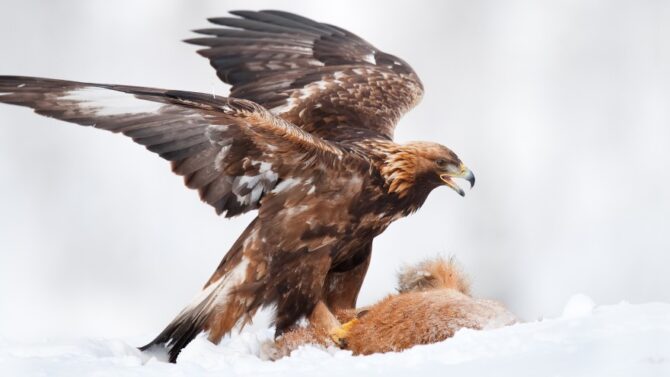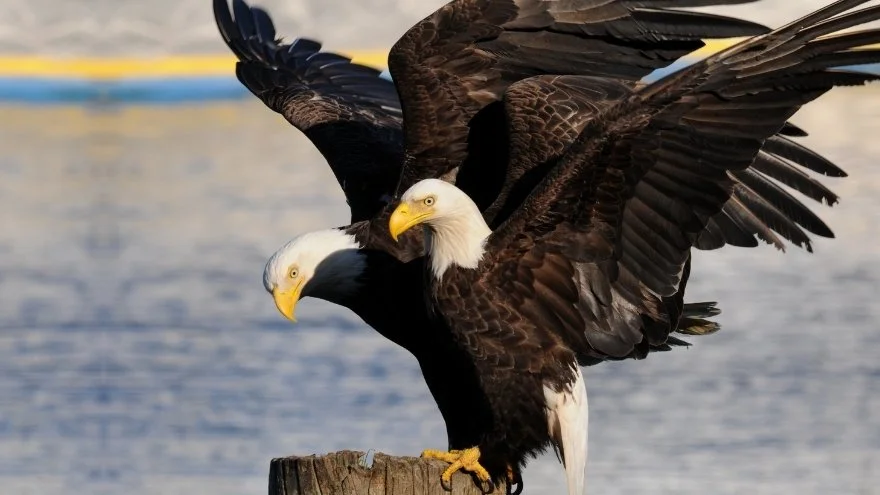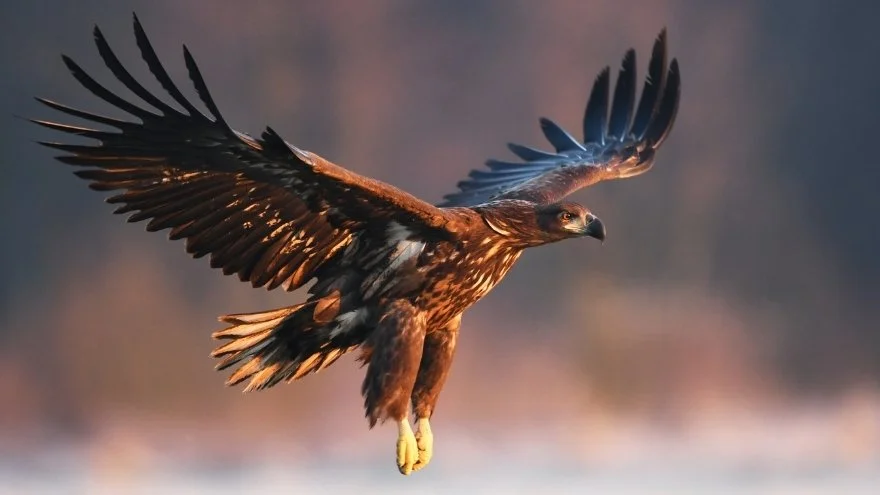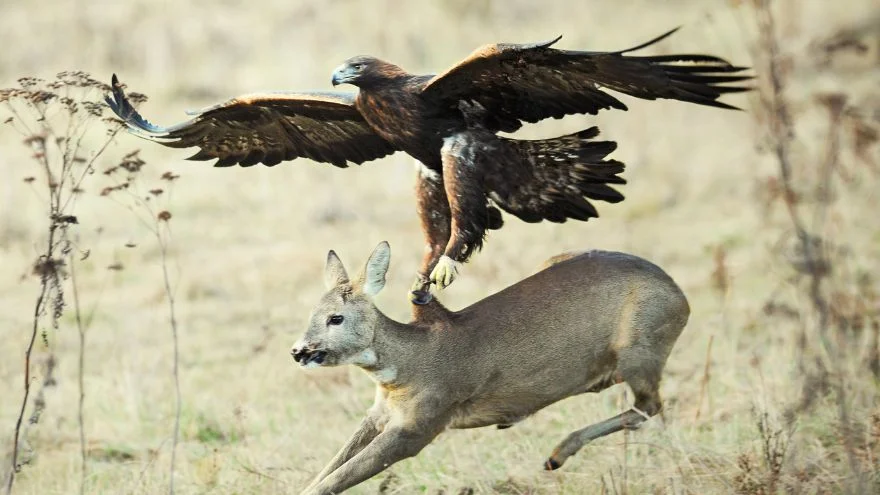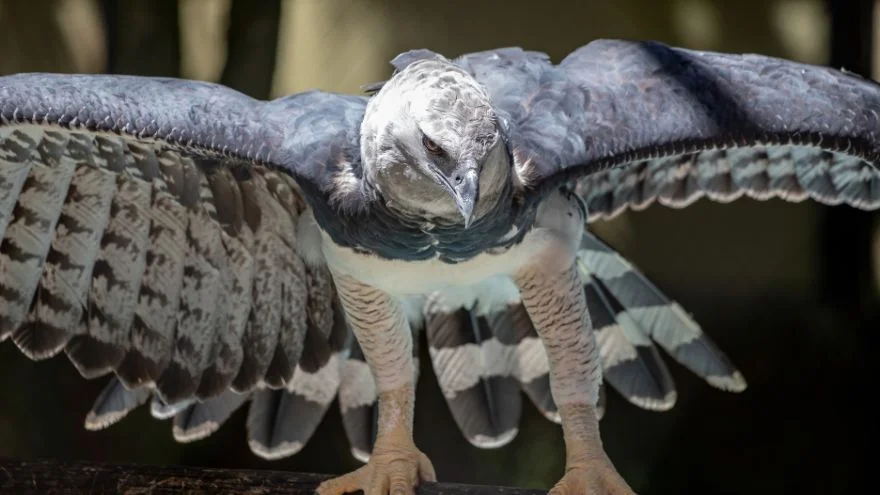The eagle is a group of birds that fall under the Accipitridae family. A proud bird and apex predator, it dominates the sky.
It is known for its sharp eyesight, and every year people who go out to observe birds love to get a glimpse of an eagle in flight.
The term ‘Eagle’ regroups many birds of prey, and there are more than 60 of them that can be found today.
These birds have faced a lot, and many species find themselves in danger of extinction. Others are highly protected, and for good reasons. We do not want to lose the king of birds, as they are termed.
Let’s delve into the specifics of this amazing bird and see what we can learn from it.
Scientific Classification
| Kingdom | Animalia |
| Phylum | Chordata |
| Class | Aves |
| Order | Accipitriformes |
| Family | Accipitridae |
| Scientific Name | Accipitridae |
Characteristics
| Height | 15.7 to 39.3 inches |
| Weight | 1.1 to 39.3 pounds |
| Venom/Poison | No |
| Habitat | Rivers, lakes, coastal regions |
| Range | Worldwide |
| Diet | Carnivore (Main prey: Fish, mammals, reptiles) |
| Life span | 15 to 30 years |
| Gestation Period | 34 to 36 days |
| Conservation status | Near Threatened |
Important Facts About Eagles
1. The eagle is a symbol of strength
In many cultures and civilizations, the bird has represented strength and power.
Russia, Rome, Mexico, Scotland, Namibia, Zimbabwe, Albania, the United States, and the Philippines are some examples of states that have an eagle as an emblem.
This isn’t surprising given its strength. It can lift an object that’s 4 times its body weight, showing how strong it is.
A species is considered the strongest eagle in the world, according to the Guinness World Record. It also has a strong eye.
It isn’t only a symbol of strength. It also stands for peace, freedom, and even faith.
The Bible describes a person of faith as an eagle soaring in the sky.
2. Their grip is 10 times as strong as a human
Have you ever been held tightly by someone? Chances are, it must have hurt.
The eagle’s grip is 10 times stronger than that of a human, making it a bird you don’t want to toy with. The grip will most likely break your bones.
They use this grip to pick up prey from the ground. They hardly hunt other birds flying with them.
Rather, they sight their meal using that strong eyesight. Then, they swoop down and grab.
3. They lose feathers and grow new ones
Eagles go through a molting process where they ‘shed’ all their feathers, dropping them one after the other. Some species lose the feathers equally on both sides to maintain balance.
They do this to rejuvenate during a period of their lives when age and time start catching up with them.
Their feathers become dirty and oily, making them heavy. Their once impeccable eyesight becomes weak and the beak—as well as the talon—starts to break.
After all the feathers fall off, it grows back again.
4. They live up high
These birds love to build nests at high points, both to protect their eggs and possibly to get there with ease.
For example, the golden eagle builds its nest at the top of a cliff for the reasons we mentioned and to also have an access to food.
Some build their nests on trees, and they try to stand guard as the high point doesn’t always deter egg thieves, especially animals like monkeys and hawks.
5. A group of eagles is called a convocation

Eagles don’t always move in groups, but some species are sociable and will come together after the breeding season.
This group is called a convocation, the word referring to the gathering of a large number of individuals. It is a befitting term.
However, this isn’t the only word used to describe a group of eagles.
It can also be called a soar (for obvious reasons), a colony, an eyrie, a flock, a brood, etc.
General Description
The only birds that come close to the eagle’s size are vultures and condors.
Eagles are considered one of the biggest birds in the world, with the largest species weighing more than 30 pounds.
They are even bigger than hawks, the birds they have ties with. It is believed that they probably evolved from hawks.
A unique trait is the beak, curved downwards at the end and heavy enough to serve as a hunting tool.
Their feet have what is called ‘spicules’ which serve them well in grabbing prey.
They come with fully feathered heads—even the bald eagle has head feathers—which sets them apart from the vulture.

While we have numerous species, some are common. Let’s take a look at them:
- The bald eagle is endemic to the United States, and it got its name from the old English word ‘balde’ which means white-headed. It is the national bird of the United States, and it is respected because it represents strength and freedom.
- The harpy eagle is located in other parts of the Americas like Mexico. It inhabits tropical rainforests and is recognized by its dark grey upper feathers with white underneath. It also has a grey head and a black band on the neck.
- The golden eagle is the most widespread of all eagle types. It can be found in North America, Europe, Asia, and North Africa. It is usually dark brown with pale wing feathers. The only gold color this bird has is on the scruff.
- The stellar’s sea eagle can be found in Northeast Asia where it inhabits the coastal regions. It has a dark body, yellow bills, and white on most other parts of its body like the shoulders, forehead, thighs, and tails.
- The white-tailed eagle can be found in Northern Europe and Asia where it stays close to water bodies. Its body feathers are brown, the tail feathers are white and the head is pale alongside the neck.
Behavior
Eagles are solitary birds, though some species have a social life. They wouldn’t also be alone when they have mates, but in general, they have no rigid social structure.
Their small family unit is enough, and there is limited social contact after that. They love their privacy and often remain in a territory, though some may migrate during winter.
These birds aren’t known to make any sounds except during their breeding season.
The only species that is vocal is the bald eagle. It has a loud, harsh call that it uses to warn away intruders or communicate with any other bald eagle that is in its proximity.
These birds are diurnal with a wake time that falls at 10 a.m. They get their breakfast during that morning period. Bird watchers often come out in the morning to get a glimpse of this bird before it takes off.
By afternoon, it’ll be hard to see one up close as it’ll either be soaring high or resting. In the evening, they hunt for dinner. They retire to sleep at night, usually on a tree branch or a nest. They can sleep standing or lie in the nest.
One reason the bird is diurnal is due to its weak night vision. During the day, the eagle’s sight is strong, more than that of a human.
Distribution and Habitat
Eagles have a wide range, being distributed everywhere in the world besides the cold regions of Antarctica.
Most species are concentrated in Africa, Europe, and Asia. Others fall in the Americas and Australia, and by ‘others’ we mean 14 species.
They also have a vast habitat, and while the preferred ones seem to be rivers, lakes, and coastal regions, those aren’t the only places you will find these birds.
They also live in rainforests, tundras, and even deserts. Their nests are built with materials like moss, grass, plant stalks, seaweed, and sod.
Eagle Diet
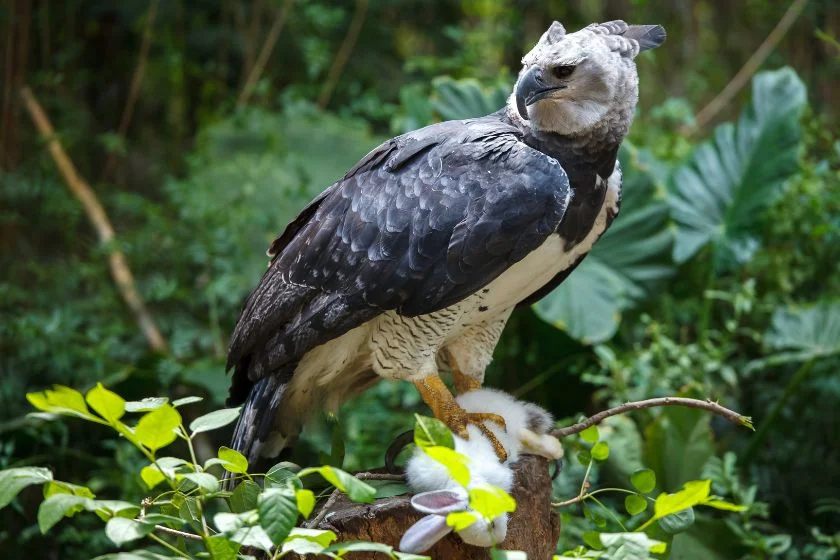
Eagles are carnivores and apex predators that spend a good part of their active days hunting.
Judging from their physical features alone (the beaks and strong talons) no one will doubt that the eagle is a bird of prey.
Never one to miss out on an opportunity, it can eat both living and dead animals, even stealing the kills of others. All is fair in hunting.
These birds employ a ‘feast or famine’ method of feeding. They can go for several weeks without feeding, then hunt down and eat a lot. Parents also hunt to feed their eaglets who are still unable to leave their nests.
They feast on fish, crabs, reptiles, smaller birds, amphibians, rodents, and mammals.
Some have been known to hunt big mammals like deer and pigs. If it can’t carry the animal out, it kills and eats on the spot. They like to vary their diet and will hunt whatever is available in their habitat.
Reproduction and Mating Process
Eagles are monogamous, and they tend to mate for life. Unlike some other animals, they do not mate with multiple partners.
Some only change partners when their current one dies. Their loyalty is admirable.
The pair is usually formed in a courtship display, an intricate one that involves a lot of performance meant to impress the opposite sex.
Once two birds form a strong bond (somewhat akin to humans falling in love) they pair for life.
This mating is advantageous for otherwise solitary eagles as they can build a nest with their mate, produce offspring and take turns protecting the offspring.
The nests are called eyries, and both sexes have a hand in building them. They often use the nest when raising their eaglets. When the eaglets are old enough to leave the nest, it becomes abandoned.
The male mate by mounting the female in flight. He moves his cloaca with hers to transfer sperm.
This copulating can happen several times a day. When the female lays the egg, she isn’t left alone to take care of the eggs.
The male stays behind to help by hunting and providing. Females lay up to four eggs, though as eaglets one might kill off others.
Predators and Threats
As apex predators, the adults have few predators. Mammals like tigers and lions that sometimes hunt on eagles can only do so when the latter is injured or distracted.
The biggest threats to these birds are humans, especially during the 20th century. There has been a sharp decline of our royal birds since then.
Factors that contributed to the decline include:
- Overhunting
- Pesticide
- Habitat loss
This is why surviving species are being protected, and it is even illegal to pick up a bald eagle’s feather in the United States. You may end up paying a huge fine.
Adults may not have many predators, but the same can’t be said for eggs and eaglets. Hawks, owls, raccoons, bobcats, and monkeys can steal and eat an eagle’s eggs.
Male vs Female
Using the bald eagle as a case study, we can generally say that the female is bigger than the male.
No one is sure why, but it is also consistent with other common species. Females also have bigger talons and a deeper beak. The female’s wingspan is also bigger.
The smaller size of the male helps it with hunting and providing while the female has a big size to help with incubation and reproduction.
While the size difference is obvious, you might not notice it until you observe a male and female flying or sitting side by side.
Another difference in both sexes is their voices. Females have a lower vocal pitch, unlike humans where women generally have a higher pitch.
This could be because of the size difference. The vocal distinctions aren’t noticeable to the human ears, though.
Frequently Asked Questions
How many eagles are there in the world?
There isn’t a certain population of eagles in the world, but most of the eagles around are considered healthy. There are more than 100,000 bald eagles, the same as the golden eagle. The harpy and steppe eagles are on a decline, sadly.
Is the eagle the same as a hawk?
The eagle and the hawk are alike, so much so that evolutionary biologists theorize that the eagles may have evolved from the hawk. The major difference between both birds is their size. Hawks are smaller than eagles.
Are there eagles at zoos?
Eagles can be found in different zoos around the world. The bald eagle in the United States is located in numerous zoos like the San Diego zoo, the Saint Louis zoo, the Lincoln Park zoo, the Houston zoo, and the San Francisco zoo.
Can an eagle be a pet?
The direct answer is a no. It is illegal to keep an eagle as a pet, as well as other protected birds. Only a certified falconer is permitted to keep a pet.
Final Thoughts
There’s a lot to know about the eagle, but with our profile, you should have sufficient information on the basics like mating and diet.
The eagle is an important part of our planet, and we are grateful that the population of species like the bald eagle and the golden eagle is growing.
We discourage any form of hunting following the law.
